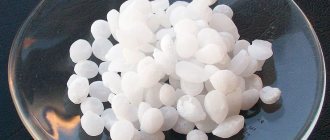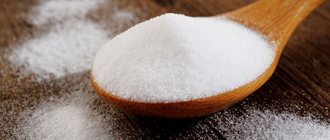Ammonia
(hydrogen nitride) is a chemical compound of nitrogen and hydrogen with the formula NH3; under normal conditions, it is a colorless gas with a sharp, characteristic odor.
The density of ammonia is almost half that of air, MPC.z. 20 mg/m3 - IV hazard class (low-hazardous substances) according to GOST 12.1.007. The solubility of NH3 in water is extremely high - about 1200 volumes (at 0 °C) or 700 volumes (at 20 °C) per volume of water. In refrigeration technology it is called R717, where R is Refrigerant (refrigerant), 7 is the type of refrigerant (inorganic compound), 17 is the molecular weight.
Ammonia is one of the most important products of the chemical industry; its annual global production exceeds 180 million tons.
The ammonia molecule is shaped like a triangular pyramid with a nitrogen atom at the top. Three unpaired p-electrons of the nitrogen atom participate in the formation of polar covalent bonds with the 1s-electrons of three hydrogen atoms (N - H bonds), the fourth pair of outer electrons is lone, it can form a covalent bond via a donor-acceptor mechanism with a hydrogen ion, forming an ion ammonium NH4+. The non-bonding two-electron cloud is strictly oriented in space, so the ammonia molecule has high polarity, which leads to its good solubility in water.
In liquid ammonia, the molecules are connected to each other by hydrogen bonds. A comparison of the physical properties of liquid ammonia with water shows that ammonia has lower boiling points (tboiling −33.35 °C) and melting points (tmelting −77.70 °C), as well as lower density and viscosity (7 times less than the viscosity of water ), conductivity (almost does not conduct electric current) and dielectric constant. This is to some extent explained by the fact that the strength of hydrogen bonds in liquid ammonia is significantly lower than that of water; and also by the fact that an ammonia molecule has only one pair of unshared electrons, in contrast to two pairs in a water molecule, which does not make it possible to form a branched network of hydrogen bonds between several molecules. Ammonia easily transforms into a colorless liquid with a density of 681.4 kg/m³, which strongly refracts light. Like water, liquid ammonia is highly associated, mainly through the formation of hydrogen bonds. Liquid ammonia is a good solvent for a very large number of organic, as well as many inorganic compounds. Solid ammonia is cubic crystals.
Pharmacodynamics and pharmacokinetics
The product has an irritating effect on skin exteroreceptors and provokes local release of prostaglandins , kinins and histamine . In the spinal cord it functions as a liberator of enkephalins and endorphins , which block the flow of pain impulses from pathological foci.
When it enters the upper respiratory tract, it interacts with the endings of the trigeminal nerve and reflexively excites the respiratory center. A concentrated solution causes colliquation (softening and dissolution) of microbial cell proteins.
With any method of administration, it is quickly eliminated from the body (mainly by the bronchial glands and lungs). Reflexively affects the tone of the vascular walls and the activity of the heart.
At the site of application, when applied externally, it dilates blood vessels, improves tissue regeneration and trophism, and also stimulates the outflow of metabolites.
When the skin is irritated, it causes similar reflexes in segmentally located muscles and internal organs, helping to restore impaired functions and structures.
Suppresses the focus of excitation, which supports the pathological process, reduces muscle tension, hyperalgesia, relieves vascular spasm, thus providing a distracting effect.
With prolonged contact, it burns the mucous membranes and skin, which is accompanied by tissue hyperemia, the development of swelling and pain.
Oral administration in small concentrations stimulates the secretion of glands, affecting the vomiting center, reflexively increasing its excitability and causing vomiting.
The drug does not enter the bloodstream.
Biological role
Ammonia is an important source of nitrogen for living organisms. Despite the high content of free nitrogen in the atmosphere (more than 75%), very few living creatures are able to use the free, neutral diatomic nitrogen of the atmosphere, N2 gas. Therefore, to include atmospheric nitrogen into biological circulation, in particular into the synthesis of amino acids and nucleotides, a process called “nitrogen fixation” is necessary. Some plants depend on the availability of ammonia and other nitrogen compounds formed in the soil as a result of the decomposition of organic (plant and animal) residues. Others, such as legumes, take advantage of a symbiosis with nitrogen-fixing bacteria (rhizobia), which are able to synthesize ammonia from atmospheric nitrogen using enzymes called nitrogenases. Although it is unlikely that biomimetic methods will ever be developed that can compete in productivity with chemical methods for producing ammonia from nitrogen, scientists are nevertheless making great efforts to better understand the mechanisms of biological nitrogen fixation. Scientific interest in this problem is partly motivated by the unusual structure of the active catalytic site of the nitrogen-fixing enzyme (nitrogenase), which contains an unusual bimetallic molecular assembly Fe7MoS9.
Ammonia is also an end by-product of amino acid metabolism, namely the product of deamination catalyzed by enzymes such as glutamate dehydrogenase. Excretion of unchanged ammonia is a common route for ammonia detoxification in aquatic creatures (fish, aquatic invertebrates, and some amphibians). In mammals, including humans, ammonia is usually quickly converted to urea, which is much less toxic and, in particular, less alkaline and less reactive as a reducing agent. Urea is the main component of urine solids. Most birds, reptiles, insects, and arachnids, however, emit uric acid rather than urea as the main nitrogen residue.
Ammonia also plays an important role in both normal and pathological animal physiology. Ammonia is produced during normal amino acid metabolism, but is highly toxic in high concentrations. Animal livers convert ammonia to urea through a series of sequential reactions known as the urea cycle. Impaired liver function, such as that seen in cirrhosis, can impair the liver's ability to detoxify ammonia and convert it into urea, resulting in increased levels of ammonia in the blood, a condition called hyperammonemia. A similar result - an increase in the level of free ammonia in the blood and the development of hyperammonemia - is caused by the presence of congenital genetic defects in urea cycle enzymes, such as ornithine carbamyltransferase. The same result can be caused by a violation of the excretory function of the kidneys in severe renal failure and uremia: due to a delay in the release of urea, its level in the blood increases so much that the “urea cycle” begins to work “in the opposite direction” - excess urea is hydrolyzed back by the kidneys into ammonia and carbon dioxide gas, and as a result, the level of ammonia in the blood increases. Hyperammonemia contributes to disturbances of consciousness and the development of soporous and comatose states in hepatic encephalopathy and uremia, as well as to the development of neurological disorders often observed in patients with congenital defects of urea cycle enzymes or organic acidurias.
Less pronounced, but clinically significant, hyperammonemia can be observed in any process in which increased protein catabolism is observed, for example, with extensive burns, tissue compression or crush syndrome, extensive purulent-necrotic processes, gangrene of the extremities, sepsis, etc., and also for some endocrine disorders, such as diabetes mellitus, severe thyrotoxicosis. The likelihood of hyperammonemia occurring in these pathological conditions is especially high in cases where the pathological condition, in addition to increased protein catabolism, also causes a pronounced impairment of the detoxifying function of the liver or the excretory function of the kidneys.
Ammonia is important for maintaining normal acid-base balance in the blood. After ammonia is formed from glutamine, alpha-ketoglutarate can be further broken down to form two bicarbonate molecules, which can then be used as a buffer to neutralize dietary acids. The ammonia obtained from glutamine is then excreted in the urine (both directly and in the form of urea), which, taking into account the formation of two bicarbonate molecules from ketoglutarate, results in a total loss of acids and a shift in blood pH to the alkaline side. In addition, ammonia can diffuse through the renal tubules, combine with and be excreted with a hydrogen ion (NH3 + H + ⟶ NH4 +), and thereby further promote the elimination of acids from the body.
Ammonia and ammonium ions are a toxic byproduct of metabolism in animals. In fish and aquatic invertebrates, ammonia is released directly into the water. In mammals (including aquatic mammals), amphibians, and sharks, ammonia is converted to urea in the urea cycle because urea is much less toxic, less chemically reactive, and can be more efficiently “stored” in the body until it can be excreted. In birds and reptiles, ammonia produced during metabolism is converted to uric acid, which is a solid residue and can be excreted with minimal loss of water.
Ammonia solution: instructions for use
The instructions for use of ammonia indicate that the dose of the drug is selected individually depending on the indications.
In surgical practice, the solution is used as a hand wash according to the Spasokukotsky-Kochergin method, diluting 50 ml of solution in 1 liter of boiled water (warm).
When used to induce breathing, the solution is applied to gauze or cotton wool. For insect bites, it is used as a lotion.
The use of ammonia in gardening
The use of ammonia for plants is quite diverse: it is used against aphids, for treating onions against onion flies, and for feeding plants.
Ammonia for aphids is used at the rate of 2 tbsp. spoons per 10 liters of water. You should also add a little washing powder to the bucket - this will ensure better adhesion. The solution is used to spray plants.
Ammonia as a fertilizer: in this case, take 50 ml of solution per 4 liters of water. The product is not only a good fertilizer for indoor and garden plants, but also allows you to get rid of midges and mosquitoes.
To water the onions, dilute 1-2 tbsp in a bucket of water. spoons of ammonia. It is recommended to water plants with this product from the moment of planting until the end of June.
How to clean gold?
There are several ways to clean gold with ammonia.
You can mix 1 teaspoon of alcohol with a glass of water and 1 tbsp. spoon of any detergent, or you can add to water (200 ml), ammonia (1 teaspoon), hydrogen peroxide (30 ml), half a teaspoon of liquid detergent.
In the first case, the jewelry is placed in the cleaning solution for an hour or two, in the second - for 15 minutes. After cleaning, the gold should be rinsed in water and wiped dry with a napkin.
How to clean silver?
To clean silver, ammonia is diluted with water in a ratio of 1:10 (1 part alcohol to 10 parts water). Silver items are left in the solution for several hours, then rinsed in water and wiped with a soft cloth.
To regularly clean silver, use a soap solution to which a small amount of ammonia is added.
Ammonia for cockroaches and ants
To combat ants, 100 ml of solution is diluted in a liter of water and the furniture in the kitchen is washed with this product. To get rid of cockroaches, wash the floor with ammonia.
Ammonia for heels
As a means to soften rough skin on the feet, ammonia is mixed with glycerin (1:1). The product is applied to the feet before going to bed, and socks are put on top.
Examples of problem solving
| Exercise | Write a formula for the compound of iron and sulfur if the mass ratio of the elements in it is m(Fe):m(S) = 7:4. |
| Solution | In order to find out in what relationships the chemical elements in the molecule are located, it is necessary to find their amount of substance. It is known that to find the amount of a substance one should use the formula: |
Let's find the molar masses of iron and sulfur (we'll round the values of relative atomic masses taken from D.I. Mendeleev's Periodic Table to whole numbers). It is known that M = Mr, which means (S) = 32 g/mol, and M(Fe) = 56 g/mol.
Then, the amount of substance of these elements is equal to:
n(S) = 4 / 32 = 0.125 mol.
n (Fe) = m (Fe) / M (Fe);
n (Fe) = 7 / 56 = 0.125 mol.
Let's find the molar ratio:
n(Fe) :n(S) = 0.125: 0.125 = 1:1,
those. The formula for the compound of copper and oxygen is FeS. It is iron(II) sulfide.
| Exercise | Calculate the mass of 2 moles of hydrogen gas and the number of molecules in this amount of substance. |
| Solution | Let's write the formula for calculating the amount of substance: |
Then, the mass of the substance can be calculated as:
Let's find the molar mass of molecular hydrogen (the value of the relative atomic mass taken from D.I. Mendeleev's Periodic Table, rounded to the nearest whole number). It is known that M = Mr, which means (H2) = 2×Ar(H) = 2×1 = 2 g/mol.
Let us determine the mass of 2 moles of hydrogen gas:
The number of molecules is denoted by N and is calculated by the formula:
This is a dimensionless quantity. Let's find the number of nitrogen molecules in 2 moles of this substance:
N(H2) = 2 × 6.023 × 10 -23 = 12.046 × 10 -23 molecules.
Source
Overdose. Impact of ammonia vapor on the human body
An overdose causes increased manifestations of adverse reactions. Thus, the effect on the human body of a high dose of ammonia solution when taken orally is manifested:
- vomiting with a characteristic odor of ammonia;
- diarrhea with tenesmus (false painful urge to defecate);
- swelling of the larynx;
- runny nose;
- cough;
- excitement;
- convulsions;
- collapse.
In some cases, death (the patient dies when taking 10-15 g of ammonium hydroxide ).
Treatment for overdose is symptomatic.
Sometimes people wonder what will happen if they drink ammonia. You should be aware that oral administration of the solution in its pure form can cause severe burns of the digestive canal.
Symptoms of ammonia poisoning
Human exposure to ammonia when inhaling its vapors manifests itself in the form of irritation of the mucous membranes of the eyes and respiratory tract. In this case, the intensity of irritation depends on the gas concentration.
Signs of ammonia vapor poisoning:
- profuse lacrimation;
- salivation;
- increased breathing;
- increased sweating;
- facial hyperemia;
- feeling of heaviness and tightness in the chest;
- chest pain;
- whooping cough;
- sneezing;
- runny nose;
- swelling of the larynx and spasm in the vocal cords;
- anxiety;
- suffocation;
- convulsions;
- loss of consciousness.
With prolonged exposure, ammonia vapor provokes severe muscle weakness, a person's blood circulation is impaired, symptoms indicating respiratory distress, as well as pain, severe burning and swelling of the skin occur.
Regularly repeated exposure to ammonia leads to systemic disorders, which are manifested by eating disorders , deafness , catarrh of the upper respiratory tract , heart failure , and death .
To protect against the harmful effects of ammonia, rinse your face and skin unprotected by clothing generously with water and cover your face with a respirator (gauze bandage or gas mask) as soon as possible. It is good if the respirator or bandage used is soaked in water with citric acid (2 teaspoons per glass of water).
You should be aware that liquid ammonia causes severe burns. For this reason, it is transported in yellow-painted steel cylinders, special tankers, road and rail tanks.
What to do if there is an ammonia release?
If you receive information about an ammonia leak, you should protect your skin and respiratory organs and leave the emergency area in the direction indicated in the radio or television message.
From the chemical damage zone you need to go in a direction perpendicular to the direction of the wind.
In case of fire, it is prohibited to approach the source of fire. Ammonia containers should be cooled from as far away as possible. To extinguish, use air-mechanical foam or sprayed water.
If there is no way to leave, you should urgently seal the room. Having got out of the danger zone, take off outer clothing (leave things outside), take a shower, rinse the nasopharynx and eyes with water.
In case of an accident, you should take shelter in the lower floors of the building.
First aid for poisoning
In case of poisoning, the victim should be taken out of the affected area. In cases where this is not possible, provide access to oxygen.
The mouth, throat and nasal cavity are washed with water for 15 minutes, the eyes are instilled with a 0.5% solution of Dicaine and, if necessary, additionally covered with a bandage. To make rinsing more effective, you can add glutamic or citric acid to the water.
Even with a slight degree of poisoning, the patient should be provided with absolute rest over the next 24 hours.
If the substance gets into an open area of the body, it is washed abundantly with water and covered with a bandage.
If ammonia enters the digestive canal, it is necessary to rinse the stomach.
Poisoning of any degree requires contacting a medical facility and, if the doctor deems it necessary, subsequent hospitalization.
After completing the course of treatment, the patient may retain certain neurological disorders, for example, loss of memory of individual events and facts, tics with various clinical manifestations, decreased hearing and pain sensitivity threshold. A common outcome is clouding of the lens and cornea of the eye.
Ammonia: ways of neutralization in the body
The main route of binding of the substance is the biosynthesis of urea, which occurs in the ornithine cycle in liver cells. As a result of this synthesis, urea - a substance that is not harmful to the body.
Ammonia is also transported in the blood in the form of glutamine , which is a non-toxic neutral compound and easily passes through cell membranes.
Another transport form of it is alanine .
Story
Ammonia was first isolated in its pure form by J. Priestley in 1774, who called it “alkaline air”. Eleven years later, in 1785, C. Berthollet established the exact chemical composition of ammonia. Since that time, research has begun around the world on producing ammonia from nitrogen and hydrogen. Ammonia was very necessary for the synthesis of nitrogen compounds, since their production from Chilean saltpeter was limited by the gradual depletion of the latter's reserves. The problem of decreasing nitrate reserves became more acute towards the end of the 19th century. Only at the beginning of the 20th century was it possible to invent a process for the synthesis of ammonia suitable for industry. This was carried out by F. Haber, who began working on this problem in 1904 and by 1909 had created a small contact apparatus in which he used increased pressure (in accordance with Le Chatelier’s principle) and an osmium catalyst. On July 2, 1909, Haber tested the apparatus in the presence of K. Bosch and A. Mittasch, both from the Baden Aniline and Soda Works (BASF), and obtained ammonia. By 1911, K. Bosch had created a large-scale version of the apparatus for BASF, and then the world's first ammonia synthesis plant was built and put into operation on September 9, 1913, which was located in Oppau (now a district within the city of Ludwigshafen am Rhein) and belonged to BASF. In 1918, F. Haber won the Nobel Prize in Chemistry “for the synthesis of ammonia from its constituent elements.” In Russia and the USSR, the first batch of synthetic ammonia was produced in 1928 at the Chernorechensky Chemical Plant.
special instructions
What is ammonia? Characteristics, physical and chemical properties of ammonia
Ammonia or hydrogen nitride (NH3) is a colorless gas (like hydrogen, ether, oxygen). The substance has a sharp irritating odor and releases into the atmosphere producing smoke. The name of the substance in Latin is Ammonium.
Molar mass - 17.0306 g/mol. MPC r.z. is 20 mg/m3. Taking into account this parameter, ammonia is classified as a low-hazard substance (hazard class IV).
NH3 is extremely soluble in water: at 0°C, about 1.2 thousand volumes of this substance dissolve in one volume of water, and at a temperature of 20°C - about 700 volumes.
It has the properties of alkalis and bases.
Used as a refrigerant for refrigeration equipment. It is marked R717, where R stands for “refrigerant” (Refrigerant), “7” indicates the type of refrigerant (in this particular case, that ammonia is not an organic substance), the last 2 digits are the molecular weight of the substance used.
In liquid hydrogen nitride, the molecules form hydrogen bonds. The dielectric constant, conductivity, viscosity and density of liquid NH3 are lower than that of water (the substance is 7 times less viscous than water), the boiling point of the substance is bp -33.35°C, it begins to melt at a temperature of -77.70°C
Like water, liquid NH3 is a highly associated substance due to the formation of hydrogen bonds.
The substance practically does not transmit electric current and dissolves many organic and inorganic compounds.
In solid form, NH3 appears as colorless crystals with a cubic lattice.
The decomposition of hydrogen nitride into nitrogen and hydrogen becomes noticeable at temperatures exceeding 1200-1300°C, in the presence of catalysts - at temperatures above 400°C.
Ammonia does not burn in air, but under other conditions, namely in pure oxygen, it ignites and burns with a yellow-green flame. When a substance burns in excess oxygen, nitrogen and water vapor are formed.
The combustion reaction of ammonia is described by the following equation: 4NH3 + 3O2= 2N2 + 6H2O.
Catalytic oxidation of NH3 at a temperature of 750-800°C allows one to obtain nitric acid (the method is used for the industrial production of HNO3).
Process stages:
- catalytic oxidation with oxygen to NO;
- conversion of NO to NO2;
- absorption of a mixture of NO2 and O2 by water (dissolution of nitric oxide in water and production of acid);
- purification of gases released into the atmosphere from nitrogen oxides.
The reaction of ammonia with water produces ammonia hydrate (ammonia water or caustic ammonia). The chemical formula of the hydrate is NH3·H2O.
How is caustic ammonia produced in industry? In industry, the synthesis of an ammonia solution with a concentration of 25% is carried out by saturating water with ammonia, which is formed as a result of coking coal in a coke oven, or with synthetic ammonia gas.
What is ammonia water used for? Nitrogen fertilizers, soda, and dyes are obtained from aqueous solutions of ammonia.
Ammonia: obtained from nitric acid in the laboratory
To obtain NH3 from HNO3, place the test tube in a stand in an almost horizontal position, but so that the acid does not flow out of it.
A few drops of HNO3 are poured into the bottom of the test tube and several pieces of zinc or iron filings are placed into it using tweezers. Reduced iron should be placed at the opening of the test tube (so that it does not come into contact with nitric acid).
The test tube must be closed with a stopper with a drain tube and slightly heated. Heating will increase the rate of ammonia release.
What does ammonia react with?
Ammonia reacts with organic substances. The products of the reaction of ammonia with α-chloro-substituted carboxylic acids are artificial amino acids.
As a result of the reaction, hydrogen chloride (HCl gas) is released, which, when combined with excess ammonia, forms ammonium chloride (or ammonia NH4Cl).
A large number of complex compounds contain ammonia as a ligand.
Ammonium salts are colorless solids with a crystalline lattice. Almost all of them are soluble in water, and they have the same properties as the metal salts known to us.
The product of their interaction with alkalis is ammonia:
NH4Cl + KOH = KCl + NH3 + H2O
The reaction described by the formula, if indicator paper is additionally used, is a qualitative reaction to ammonium salts. The latter interact with acids and other salts.
Some ammonium salts evaporate (sublimate) when heated, while others decompose.
NH3 is a weak base, so the salts it forms in an aqueous solution undergo hydrolysis.
Weaker bases than ammonia are aromatic amines - NH3 derivatives in which hydrogen atoms are replaced by hydrocarbon radicals.
Reactions of ammonia with acids
Adding concentrated hydrochloric acid to an NH3 solution is accompanied by the formation of white smoke and the release of ammonium chloride NH4Cl (ammonia).
The reaction of sulfuric acid and ammonia produces white crystals of (NH4)2SO4 - ammonium sulfate.
If you add nitric acid to NH3, white ammonium nitrate NH4 NO3 is formed.
When chloroacetic acid reacts with NH3, the chlorine atom is replaced by an amino group, resulting in the formation of aminoacetic acid.
If NH3 is passed through hydrobromic acid, ammonium bromide is formed (the reaction is described by the formula - HBr + NH3 = NH4Br).
Ammonia: heavier or lighter than air?
Compared to air, NH3 has almost half the density, so its vapor always rises. However, under certain conditions, an ammonia aerosol can form - a suspension of droplets of this substance in a gas. This aerosol is usually heavier than air and is therefore more dangerous than NH3 gas.
Is hydrogen nitride a complex or simple substance?
Hydrogen nitride is formed by atoms of different elements, therefore it is a complex inorganic compound.
Molecular structure of ammonia
Ammonia is characterized by a crystal lattice of polar molecules, between which so-called Van Der Waals forces . There are 3 chemical bonds in the hydrogen nitride molecule; they are formed according to a covalent polar mechanism.
The molecule has the shape of a trigonal pyramid, at the top of which there is a nitrogen atom (the oxidation state of nitrogen in NH3 is “-3”).
Industrial method for producing ammonia
Producing ammonia in industry is an expensive and labor-intensive process. Industrial synthesis is based on the production of NH3 from nitrogen and hydrogen under pressure, in the presence of a catalyst and at high temperatures.
Sponge iron activated by aluminum and potassium oxides is used as a catalyst in the production of NH3 in industry. Industrial installations in which synthesis is carried out are based on the circulation of gases.
The reacted gas mixture, which contains NH3, is cooled, after which the NH3 condenses and is separated, and the hydrogen and nitrogen that have not reacted with a new portion of gases are again supplied to the catalyst.
There was also a presentation on the topic of co-production of ammonia and methanol in industry.
Current GOSTs, in accordance with which hydrogen nitride is produced:
- technical liquid ammonia, anhydrous ammonia - GOST 6221-90;
- aqueous ammonia - GOST 3760-79;
- technical ammonia aqueous - GOST 9-92.
The ammonia synthesis reaction can be characterized as follows: ammonia is formed as a product of a compound reaction occurring in the gas phase - direct, catalytic, exothermic, reversible, redox.
Disposal of the substance
NH3 is recycled by selectively obtaining substances that are valuable for recycling, and by a method that provides for the possibility of using waste waste as raw material for the production of other materials.
What is ammonia? Chemical formula of ammonia
Ammonia is a 10% aqueous solution of ammonia. The formula of the substance is NH4OH. The name in Latin is Solutio Ammonii caustici seu Ammonium causticum solutum.
Ammonia has found use in everyday life as a stain remover, a means for cleaning coins, dishes, plumbing fixtures, furniture, and jewelry made of silver and gold. In addition, it is used for dyeing fabrics, fighting aphids, onion moths, onion flies, ants and cockroaches, washing windows, and caring for rough skin on the feet.
The reaction of ammonia with iodine produces a very unstable adduct, which has the appearance of dry crystals, which is often used as a spectacular experiment.
Is ammonia ammonia?
Some people believe that ammonia and ammonia are the same thing. However, this opinion is wrong. Ammonia solution is ammonia or, in other words, an aqueous solution of ammonium hydroxide.
And ammonia is an ammonium salt, a slightly hygroscopic, white and odorless crystalline powder that, when heated, evaporates hydrogen nitride (ammonia). Its formula is NH4Cl.
Wikipedia indicates that the substance is used as a fertilizer (as a top dressing applied to alkaline and neutral soils under crops that react poorly to excess chlorine - rice, corn, sugar beets), as a food additive E510, flux for soldering, electrolyte components in galvanic cells and a quick fixer in photography, a smoke generator.
In laboratory conditions, ammonia is used to lyse red blood cells ; its use in medicine is advisable to enhance the effect of diuretics and relieve edema of cardiac origin.
Precautionary measures
Topical application is possible only on intact skin.
In case of accidental contact of the product with the mucous membrane of the eyes, wash the eyes with plenty of water (for at least 15 minutes) or a solution of boric acid (3%). Oils and ointments are contraindicated in this case.
If you take an ammonia solution orally, you should drink fruit juices, water, warm milk with soda or mineral water, a solution of citric (0.5%) or acetic (1%) acid until it is completely neutralized.
In case of damage to the respiratory system, fresh air and warm water inhalations with the addition of citric acid or vinegar are indicated; in case of suffocation - oxygen.
What do the smell of ammonia in urine and the ammonia smell of sweat indicate?
There are a number of reasons that could explain why your urine smells like ammonia.
As a rule, an unpleasant odor after urination is a temporary phenomenon that can be caused by:
- abuse of protein foods;
- dehydration;
- urinary retention;
- consumption of spicy seasonings.
However, urine with an odor can also signal a serious pathology:
- diabetes mellitus;
- inflammatory ( cystitis , pyelitis , urethritis ) and infectious ( gardnerellosis , chlamydia , vaginosis ) diseases of the urogenital tract;
- tuberculosis;
- renal dysfunction;
- metabolic disorders;
- malignant neoplasms.
You should know that the smell of ammonia from the mouth also indicates kidney failure
In women, discharge with an odor is possible during menopause and pregnancy (if the pregnant woman drinks little fluid and/or takes various medications and supplements).
If your sweat smells like ammonia, the cause may be kidney failure , cystitis , urinary incontinence, liver problems, cholera , or the presence of bacteria that can cause peptic ulcers. Another possible cause of body odor is following a protein diet.
Everyone knows what ammonia smells like, so if a characteristic odor appears (especially if a child’s urine smells) or an ammonia taste in the mouth, you should consult a doctor, who will accurately determine the cause of this phenomenon and take the necessary measures.
An equally alarming symptom is the smell of ammonia in the nose, which can be caused by certain diseases of the nasopharynx, pathologies of other organs, foreign bodies entering the nasal passage, head injuries (the smell may refer to olfactory hallucinations), and cancer.
Why does fish smell like ammonia?
Sometimes it happens that fish smells like ammonia. The smell can occur in 2 cases:
- if the fish was stored incorrectly and pockets of a certain type of mold appeared on it;
- if the fish lived in a polluted pond.
origin of name
Ammonia (in European languages its name sounds like “ammoniac”) owes its name to the Ammon oasis in North Africa, located at the crossroads of caravan routes. In hot climates, urea (NH2)2CO, contained in animal waste products, decomposes especially quickly. One of the decomposition products is ammonia. According to other sources, ammonia got its name from the ancient Egyptian word amonian
. This was the name given to people who worshiped the god Amun. During their rituals, they sniffed the mineral ammonia (NH4Cl), which, when heated, evaporates ammonia.
During pregnancy
During pregnancy and lactation, use is allowed only in situations where the benefit to the woman’s body outweighs the potential risk to the child.
In most cases, pregnant women try not to use ammonia in any form. Maternity dye should also not contain this substance. The list of products most suitable for pregnant women includes the following ammonia-free hair dyes:
- Igora Schwarzkopf (Schwarzkopf Igora Vibrance);
- paints from the Garnier palette (Garnier Color&Shine);
- Estelle paint, the palette of which includes 140 shades;
- ammonia-free paint from the Matrix Color Sync palette;
- Kutrin paint.
There are also many good reviews about L'Oreal ammonia-free paint (L'Oreal Professionnel LUO COLOR). However, there are women who continue to use ammonia hair dye during pregnancy.
Molecule structure
The electronic formula of ammonia is as follows:
Rice. 1. Electronic formula of ammonia.
Of the four electron pairs at the nitrogen atom, three are shared and one is lone. Three unpaired p-electrons of the nitrogen atom, whose electron orbitals are mutually perpendicular, and 1s-electrons of three hydrogen atoms participate in the formation of the NH3 molecule. The molecule has the shape of a regular pyramid: in the corners of the triangle there are hydrogen atoms, and at the top of the pyramid there is a nitrogen atom. The angle between the HNH bonds is 107.78 degrees.
Reviews
Ammonia is a remedy that has been proven over the years. Traditionally, it is used as a means to bring a person out of unconsciousness. However, there are also reviews of ammonia for hangovers.
When intoxicated, pour 5 to 10 drops of ammonia solution into a glass of water. After a drunkard drinks water, he should quickly rub his ears with his hands so that as a result of a rush of blood to his head, he will regain consciousness.
When preparing the medicine, it is important to strictly adhere to the dosage so as not to cause a burn to the esophagus. Knowledgeable people claim that this is a very effective way to get a person out of binge drinking.
Complexation
Due to their electron-donating properties, NH3 molecules can enter complex compounds as ligands. Thus, the introduction of excess ammonia into solutions of d-metal salts leads to the formation of their amino complexes:
Complexation is usually accompanied by a change in the color of the solution. Thus, in the first reaction, the blue color (CuSO4) turns into dark blue (the color of the complex), and in the second reaction the color changes from green (Ni(NO3)2) to blue-violet. The strongest complexes with NH3 are formed by chromium and cobalt in the +3 oxidation state.
Price of ammonia. Where to buy ammonia?
Ammonia is marketed under the name Ammonia solution 10%. The price of ammonia in Ukrainian pharmacies is from 2 UAH. In Russian pharmacies its price ranges from 13 to 39 rubles.
Where to buy liquid technical ammonia? You can purchase ammonia water from factories or through the official websites of manufacturers of chemical raw materials. The price of ammonia is from 8 thousand UAH per 1 ton. In Russia, the price of aqueous ammonia starts at 11.5 rubles per 1 kg.
- Online pharmacies in RussiaRussia
Content
- 1 Chemical properties
- 2 History
- 3 Origin of the name
- 4 Liquid ammonia
- 5 Complexation
- 6 Biological role
- 7 Physiological action
- 8 Application
- 9 Receipt 9.1 Consumption rates per ton of ammonia
Receipt
The industrial method for producing ammonia is based on the direct interaction of hydrogen and nitrogen:
This is the so-called Haber process (a German physicist who developed the physicochemical foundations of the method).
The reaction occurs with the release of heat and a decrease in volume. Therefore, based on Le Chatelier’s principle, the reaction should be carried out at the lowest possible temperatures and at high pressures - then the equilibrium will be shifted to the right. However, the reaction rate at low temperatures is negligible, and at high temperatures the rate of the reverse reaction increases. Carrying out the reaction at very high pressures requires the creation of special equipment that can withstand high pressure, and therefore large capital investments. In addition, the equilibrium of the reaction, even at 700 °C, is established too slowly for its practical use.
The ammonia yield (in percent by volume) per single pass of the catalyst at various temperatures and pressures has the following values:
| 100 at | 300 at | 1000 at | 1500 at | 2000 at | 3500 at | |
| 400 °C | 25,12 | 47,00 | 79,82 | 88,54 | 93,07 | 97,73 |
| 450 °C | 16,43 | 35,82 | 69,69 | 84,07 | 89,83 | 97,18 |
| 500 °C | 10,61 | 26,44 | 57,47 | No data | ||
| 550 °C | 6,82 | 19,13 | 41,16 | |||
The use of a catalyst (porous iron with Al2O3 and K2O impurities) made it possible to accelerate the achievement of an equilibrium state. Interestingly, when searching for a catalyst for this role, more than 20 thousand different substances were tried.
Taking into account all the above factors, the process of producing ammonia is carried out under the following conditions: temperature 500 °C, pressure 350 atmospheres, catalyst. The yield of ammonia under such conditions is about 30%. In industrial conditions, the circulation principle is used - ammonia is removed by cooling, and unreacted nitrogen and hydrogen are returned to the synthesis column. This turns out to be more economical than achieving a higher reaction yield by increasing the pressure.
To obtain ammonia in the laboratory, the action of strong alkalis on ammonium salts is used:
Typically, ammonia is obtained in a laboratory method by gently heating a mixture of ammonium chloride and slaked lime.
To dry ammonia, it is passed through a mixture of lime and caustic soda.
Very dry ammonia can be obtained by dissolving sodium metal in it and subsequently distilling it. This is best done in a system made of metal under vacuum. The system must withstand high pressure (at room temperature, the pressure of saturated ammonia vapor is about 10 atmospheres). In industry, ammonia is dried in absorption columns.
Consumption rates per ton of ammonia
To produce one ton of ammonia in Russia, an average of 1200 nm³ of natural gas is consumed, in Europe - 900 nm³.
The Belarusian Grodno Azot consumes 1,200 Nm³ of natural gas per ton of ammonia; after modernization, consumption is expected to decrease to 876 Nm³.
Ukrainian producers consume from 750 Nm³ to 1170 Nm³ of natural gas per ton of ammonia.
UHDE technology claims consumption of 6.7–7.4 Gcal of energy resources per ton of ammonia.
Physiological action
Ammonia is toxic. According to its physiological effect on the body, it belongs to the group of substances with asphyxiating and neurotropic effects, which, if inhaled, can cause toxic pulmonary edema and severe damage to the nervous system. Ammonia has both local and resorptive effects.
Ammonia vapors strongly irritate the mucous membranes of the eyes and respiratory organs, as well as the skin. This is what a person perceives as a pungent odor. Ammonia vapors cause excessive lacrimation, eye pain, chemical burns of the conjunctiva and cornea, loss of vision, coughing attacks, redness and itching of the skin. When liquefied ammonia and its solutions come into contact with the skin, a burning sensation occurs, and a chemical burn with blisters and ulcerations is possible. In addition, liquefied ammonia absorbs heat when it evaporates, and when it comes into contact with the skin, frostbite of varying degrees occurs. The smell of ammonia is felt at a concentration of 37 mg/m³.
The maximum permissible concentration in the air of the working area of the production premises (MPCr.z.) is 20 mg/m³. In the atmospheric air of populated areas and in residential premises, the average daily concentration of ammonia (MPC.s.) should not exceed 0.04 mg/m³. The maximum single concentration in the atmosphere is 0.2 mg/m³. Thus, the smell of ammonia indicates that the permissible limits have been exceeded.
Irritation of the pharynx occurs when the ammonia content in the air is 280 mg/m³, eyes - 490 mg/m³. When exposed to very high concentrations, ammonia causes skin damage: 7-14 g/m³ - erythematous, 21 g/m³ or more - bullous dermatitis. Toxic pulmonary edema develops when exposed to ammonia for an hour at a concentration of 1.5 g/m³. Short-term exposure to ammonia at a concentration of 3.5 g/m³ or more quickly leads to the development of general toxic effects.
In the world, the maximum concentration of ammonia in the atmosphere (more than 1 mg/m³) is observed in the Indo-Gangetic Plain, in the Central Valley of the USA and in the Turkestan (formerly South Kazakhstan) region of Kazakhstan.











